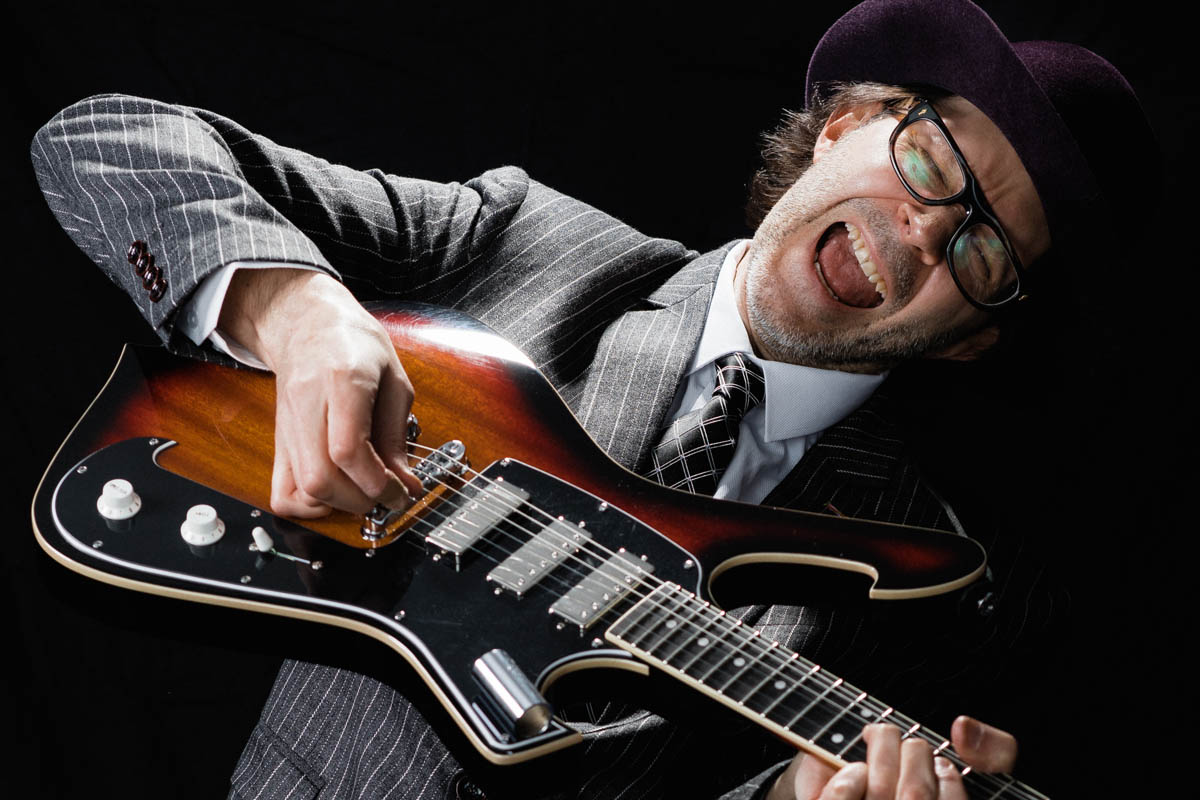Paul Gilbert: “Hendrix had his thumbs all over the guitar, beating away at it. He kinda invented Stevie Ray Vaughan when he did Killing Floor“
The affable shred pioneer talks slide, rock guitar physicality and the joys of radically modding vintage Ibanez guitars

Paul Gilbert is a guitarist known for many things. From his fret-burning work in Racer X and the mainstream melodic rock he made with Mr Big, to his deeply entertaining instructional videos and expansive solo discography, it would be fair to say he’s someone who has covered a lot of musical ground over the last three and a half decades.
He’s also the kind of player we’ve seen master pretty much every kind of technique, from string-skipping, tapping and legato to the less conventional means of using a drill in place of his right hand – though most shredders would be inclined to agree his greatest strength lies in his alternate picking.
The devastating accuracy of those three note per-string lines have never ceased to amaze and strike fear in the hearts of guitarists around the world – and no matter how many hours have been spent chasing his shadow, very few have been able to catch up with the American six-string wizard, at least in terms of sheer speed…
For me the whole flanger and phaser thing comes from Van Halen’s Unchained and Ain’t Talkin’ Bout Love. That all came from listening to Eddie, and Alex Lifeson too
“I think I recently figured out the secret behind my picking… I’ll show you!” he explains, picking up one of the Ibanez guitars on the rack next to him after welcoming MusicRadar inside his home studio via video conference. “When I was a kid I learned basic strumming before soloing stuff, songs like I’ll Cry Instead by The Beatles [plays riff]. And that was something a lot of my shred students had never learned. So I didn’t know this for a long time and I’ve reverse engineered to learn it, but to do that strum there’s some shoulder involved – and using that shift can get you from any string to the other. It’s not elbow picking, which is when the shoulder is stiff…”
Given that he – along with the rest of us – had always thought he was purely picking from the wrist, the realisation helped him understand some of the mechanics behind his own playing…
“A lot of players lock in and try to do it with the thumb or wrist – and obviously all of those work – but the shoulder is the secret,” Gilbert continues. “You can move the pick a long way, from the low E to the high E, and the most important thing is that it moves the mute. That’s the big deal.
“If someone has a good ear and musical sensibility, their technique doesn’t matter. They can make good music. But a good way to test out this technique is using the Atomic Punk intro, where Eddie Van Halen rubs the side of his hand on the strings [plays riff]. If you’re doing it that way, you’re doing it right! That’s what the motion feels like…”
Get the MusicRadar Newsletter
Want all the hottest music and gear news, reviews, deals, features and more, direct to your inbox? Sign up here.
Hendrix came and had his thumbs all over the guitar, beating away at it. He kinda invented Stevie Ray Vaughan when he did Killing Floor
That’s interesting because a lot of people might think less movement and economy in motion is the way to tackle those faster runs…
“It can be, but try to practice hitting everything and only hearing two notes. A lot of players who have their guitar up really high might find this sounds like a total mess, but lower down you can get more motion. Even if you look at the earlier Beatles stuff, they were holding their guitars up high and playing country style.
“Hendrix came and had his thumbs all over the guitar, beating away at it. He kinda invented Stevie Ray Vaughan when he did Killing Floor [plays riff]! He was really hitting those strings from the shoulder. And that’s where this all relates to fast picking… it’s a big part of being able to do faster alternate picking runs!
“In terms of the tone and making it sound good, I tend to mute the lower notes more than the higher ones. A good way to practice that is using sixth intervals on the D and B strings, always muting the bottom and lifting away for the higher note. That’s all coming from my shoulder.”
The opening fanfare of Hello North Dakota!, the first track on your latest album Werewolves Of Portland, reminds us of the lavish orchestrations Brian May helped innovate…
“Well, that’s a good name to be associated with! Brian is definitely one of my heroes. And I agree, he turned his guitar into an orchestra by overdubbing. On that particular tune, I took the state song of North Dakota and worked it out. I’m not a good sight-reader so I wrote down the letter names, like D or C or B flat or whatever it was. The melody I memorized, melodies are easy to remember, but for all the other parts I had to read along…
“It’s funny, when I was a kid there wasn’t all the video footage there is now. You’d have to get everything by ear. Maybe if you went to a concert you could see someone playing close-up for an hour. These days there’s so much footage available, you can see anyone’s hand position and how they hold the pick – all these details you could never get before. And I would have to say Brian’s positions are probably the most similar to my own out of everybody!”

In what sense?
“Obviously there are a bunch of players who I was inspired by, but I think physically me and Brian are quite similar. We’re both tall guys. When I watch his hands, I always think it kinda looks like my hands. One of the most interesting things about that era from the 60s and 70s, is that everyone was making it up as they went along.
I think physically me and Brian are quite similar. We’re both tall guys. When I watch his hands, I always think it kinda looks like my hands
“It’s not like classical piano, which had been around for so long there was an established way of doing it. Or if you go to the Yamaha School Of Violin, people have worked out this is how to play – you have to follow these rules and do it this way. If you look at guitar and how people hold the pick, sure there are similarities but there are a lot of differences too. Everybody sounds really different.
“That’s the cool thing about that era. A lot of it came from blues so you might hear that cool kind of vibrato but mostly everyone came in different shapes and sizes, and most people were self-taught and finding their own ways to do it.”

There’s also some interesting usage of flanger, ranging from subtle to more extreme settings when you are playing palm-muted arpeggios and modal passages…
“For me the whole flanger and phaser thing comes from Van Halen’s Unchained and Ain’t Talkin’ Bout Love [plays riff]. So that all came from listening to Eddie, and Alex Lifeson too – there was a slow flanger on tracks like The Spirit Of Radio [plays riff]. When I think about pedal moments of the 70s, I don’t know if it was a flanger or phase-shifter, but Phil Lynott from Thin Lizzy would have something on his parts for tracks like Waiting On An Alibi.
“A lot of my favourite players were post-Hendrix but sounded a lot like Hendrix. People like Robin Trower, Pat Travers, Frank Marino and to a smaller extent, Alex Lifeson. They’d have a lot of flanger or Leslie or chorus or phase-shifter or Uni-Vibe on their guitar sounds. I always liked those players. It seemed like their best records were live records – Mahogany Rush: Live, Robin Trower Alive, Pat Travers’ Go For What You Know, Frampton Comes Alive – which had a Leslie going almost the whole time.
“In the studio you can overdub and make things sound bigger that way, but live you might need a pedal. The live album I listened to the other day was an Aerosmith live bootleg which had the song Chip Away The Stone. I don’t know if it’s Joe Perry or Brad Whitford, but whoever started the song sounded so huge. I listen to it thinking, ‘What is going on? This is the hugest guitar tone I’ve heard in my life!’”

As well as being more bluesy, your recent work has also been more slide-led – this latest album being no exception with tracks like Argument About Pie and Meaningful. What have been the biggest challenges on that journey?
“If people never thought about me originally as a slide player, it’s because I wasn’t [laughs]! Growing up, my favourite kind of music was heavy rock. There was a certain primitive aspect that I loved but I also felt a little embarrassed about. I wanted to be a smart, educated kind of person. So I wanted to do this primitive thing but also express that I’m not a dummy.
“There was an inner battle. The way I solved it was through listening to my parents’ classical records. It didn’t move me in the same way from an energetic standpoint – it didn’t have the same energy I’d find on a rock album, but I could tell the players were really sophisticated. You could hear a classical harpsichord player and there would be zero slop. You hear a Led Zeppelin record and there’d be a clam here or there, but it would be more fun to listen to. If you put on your classical hat, you’d think, ‘Oh that’s a mistake there!’”
Growing up, my favourite kind of music was heavy rock. There was a certain primitive aspect that I loved but I also felt a little embarrassed about. I wanted to be a smart, educated kind of person
And clearly you chose to take inspiration from both camps…
“I wanted to have both qualities. The amazing energy but also the control of the instrument you get with classical players. In a way, Van Halen was the guy who put that together first. Uli Jon Roth was maybe not as famous but he certainly had that element too. And then there’s Yngwie. I guess I mention the harpsichord because I thought the kind of things a harpsichord could do, but played on guitar, would mean nobody could think I’m dumb. If I pull that out on a guitar, it gives me a kind of license that says I can do this thing and tick that box.
“So I spent a lot of time working on those kind of scaley things. A lot of my early instructionals were based around that. Then I started doing these jam sessions with Bruce Bouillet, the other guitar player in Racer X, and what do you jam when you jam? Usually blues! And Bruce would sound so much better than me because I was trying to play it too classically. It was really square and I could just tell something was off. Bruce, on the other hand, had all the right bends and licks, so I wanted to get more into that.”
So how did you overcome that – what was your gateway to Bluesville?
“Of course I had some of it down already, having jammed along to Led Zeppelin and other bluesy stuff from Chuck Berry, Frank Marino and even Van Halen, who had bluesy elements. But I was so into Yngwie Malmsteen that all the bluesy stuff had been erased. The closest thing to a blues album I owned was that Pat Travers live album…
“There were certain licks I picked up, where he bended from other places. He was playing different notes to me. It wasn’t natural minor, it had more of a swing blues feel. Later on, after years of teaching, some students coming to me only wanted to learn the harpsichord stuff. I could hear the damage I’d done with my instructional videos in their playing, thinking, ‘Oh man, I need to help them with the missing elements!’ Because a lot of them hadn’t listened to Zeppelin.
“I figured I needed to get better at it in order to teach them. I knew how to zing through a blues: A Mixolydian over A dominant, D Mixolydian over the four chord [improvises on chords]. It fit on paper and was alright for fiery stuff, but I wanted to play just two or three notes per chord and really pick the good ones… and I couldn’t! It was terrible and really humiliating. Now, 10 years on, I’ve really worked on it. And it’s a bit like playing a kazoo – you should hear in your head what you’re going to hear before you play it and hum them out. Then you need to know how to connect them over the chords or through the chords…”
Which is another of your biggest strengths – connecting different musical ideas into a conversation of sorts…
“I still throw in some of that fire, but it makes more sense because the lines are linked and connected. Now I look at blues like a language. Learning it properly was like going from English to French – it has different words, phrasing and grammar. And that in turn helped my slide playing.
“When I tried to play scales on slide, it just didn’t feel like the right tool for the job. But a lot of the vocal lines I’d learned over the years, like the song Joy To The World with that opening Jeremiah Was A Bullfrog lyric, really fit. Playing slide is like another language but once you start to know it, you realise it uses the same words. You don’t have to relearn everything. There are certain melodies that are well-worn, you’ll use them a lot… so that’s the good news!”
Playing slide is like another language but once you start to know it, you realise it uses the same words. You don’t have to relearn everything
I Wanna Cry has some really interesting rhythms that would catch even those familiar with your work a bit off-guard…
“You’re a musician, so you know there are certain things you understand, and then all these other mysteries. There are a couple of tunes on this album where I started out playing a straight 12-bar blues but it needed something else, something of my own to give it a hook.
“It starts pretty standard and then really goes to a place you might not expect, but hopefully not too weird. As it’s going along, you sorta look around – it’s like being on the freeway. Oh, here’s an exit… shall I take it?”

As for the title track, it has this wide intervallic, almost Allan Holdsworth-sounding lick...
“You know, that particular one sounds crazy but it’s so easy to play. It’s just a power chord, played on each set of strings – so the twelfth fret on the low E then the fourteenth on the A, and from there the same frets on each pair. Those are incredibly straightforward. Then I might take it to the ninth and eleventh going back up and it sounds like some crazy wide interval difficult thing. But it’s not, it’s super easy.
“And you can take it anywhere, like going from the 12th fret and to the 15th, using the 15th and 17th frets as your ‘power chord’. And it actually outlines one of my favourite chords – a dominant sus chord, which can be really good for modulating. You can almost arbitrarily put them anywhere and your ear will think, ‘Okay, if it’s that chord…’ Remember those places on the freeway I was talking about, well… there are more places to turn off! It’s strange enough to make your music feel like it’s floating and able to land anywhere.”
Another great thing about Ibanez is that even if they’re vintage, I don’t feel bad about doing stuff to them. If I want to get a new pickguard or put locking tuners on, I will
For the recordings, we heard you’d used a mix of your signature Firemans and some vintage Ibanez models… tell us more!
“It’s funny, I’ve got a student who had been collecting 80s Ibanez guitars. Mine were all 70s ones, a lot of the cool Flying V and Explorer and Les Paul copies. He was collecting Blazers and things like that, and we’d talk about them. These days we have Reverb, this amazing place for finding vintage stuff, and I thought I’d check them out. And they’re pretty inexpensive for guitars made in Japan during the 80s.
“Another great thing about Ibanez is that even if they’re vintage, I don’t feel bad about doing stuff to them. If I want to get a new pickguard or put locking tuners on, I will. The whammys are pretty cool. When I was a kid I could never get my whammys in tune and I wish I had found one of those Roadstars or Blazers, because they’re pretty good even with regular tuners.
“But once you’ve added Sperzel tuners they’re great! I just got a one that has real F-holes. I put cream tape inside to help see it better as the inside is black. We put some DiMarzios in, maybe changed a knob, and it sounds killer.”
Lean Into It, the second Mr Big album, is now celebrating its 30th anniversary. What do you remember about putting together the perfect pop rock album?
“I was excited about it. The first record had a good response and we were really fortunate to get some great support tours, mainly opening for Rush. And having a gig like that is a bit like playing baseball. Somebody pitches and it’s your job to hit it – and it’s a great ball. Suddenly we found ourselves in arenas and maybe being the support band they might have been still filling up at the beginning, but by the end, we had full arenas to play to.
“And I felt we weren’t hitting it like we could be hitting it because our songs weren’t as strong as they could be. I knew our next record needed had to have more for people to remember and connect with in terms of melodies. That was my world, though I think everyone else felt that to some extent. As a result, Lean Into It ended up being a more melodic record. Eric has this beautiful and bluesy sensibility in his vocal style, that was always going to be there, but the melodies just got bigger and stronger.
“It was a good time in the band, we still had that fighting spirit, we didn’t want to fade away. I remember our manager was so disgusted with my horrible car, he got me some publishing deal that I really didn’t deserve. He told me, ‘Go buy a car!’ And I got a 1962 Ford T-Bird, it’s this big long thing with fins that looked like the Batmobile. I drove to the studio the next day thinking, ‘Man, life is good – we’re making a great album, I’ve got my 62 T-Bird and everything is alright!’”
There are two versions of My Kinda Woman – though the Racer X version is titled Mad At The World…
“I haven’t listened to either for such a long time. I guess the biggest differences are the vocal melodies and singer. The Racer X version was my melody, I wrote most of that one – so I’ve got a connection with that because it came from me. I love what Eric did with it too. I guess the Racer X version is more metal. I was thinking ‘More Queensrÿche!’
“The Mr. Big version was probably a tricky thing for Eric, who was much more of a soul singer. But I gave him those minor-y Queensrÿche-y chords to sing over, saying ‘Good luck!’ and he not only survived it but did something great with it. That’s a credit to him, being able to step into something that wasn’t necessarily a comfortable place musically and still deliver.”
Alive And Kickin’ has some great usage of open strings in its opening G minor blues…
“I’m trying to remember the intro right now… I probably got those ideas from Led Zeppelin, using open strings a bit like Jimmy Page would. A lot of players have used those descending open-string triplets, even Rick Nielsen from Cheap Trick on the song Ain’t That A Shame [plays riff].
“It sounds a bit like random notes depending on the key. Gary Moore would use them a lot too. Gamma had a song called Ready For Action [plays riff]. Whenever anybody compliments me, I always have to explain where I got it [laughs]!”

What else have you been experimenting with recently?
“The one experiment I was doing this morning was with a double neck micro Ibanez. A lot of the time with a double neck I might have three strings on one of the necks all tuned to E. But because this one is a micro, the stretch I can get is ridiculous. I was trying to find something to fit an A7 chord and I realised that every dot on the guitar was in key. So I came up with this really wide intervallic string-skipping lick which wouldn’t be possible on a regular guitar.
“The improvement I made today was that usually I use the middle string slots, just so I can add vibrato in both directions. But this lick is easier to play on the bottom string slots. That’s something I’m working on for the next record, which I’m recording live with the band in a couple of weeks' time, which means I actually have to be able to play it. So far I’ve only worked on the colours of the guitars, clothing and gear. I’ve barely practised the music… but I’ve got that lick down, so it should be alright [laughs]!”
- Werewolves of Portland is out now via The Players Club/Mascot Label Group
Amit has been writing for titles like Total Guitar, MusicRadar and Guitar World for over a decade and counts Richie Kotzen, Guthrie Govan and Jeff Beck among his primary influences. He's interviewed everyone from Ozzy Osbourne and Lemmy to Slash and Jimmy Page, and once even traded solos with a member of Slayer on a track released internationally. As a session guitarist, he's played alongside members of Judas Priest and Uriah Heep in London ensemble Metalworks, as well as handling lead guitars for legends like Glen Matlock (Sex Pistols, The Faces) and Stu Hamm (Steve Vai, Joe Satriani, G3).
“I’m beyond excited to introduce the next evolution of the MT15”: PRS announces refresh of tube amp lineup with the all-new Archon Classic and a high-gain power-up for the Mark Tremonti lunchbox head
“These guitars travel around the world and they need to be road ready”: Jackson gives Misha Mansoor’s Juggernaut a new lick of paint, an ebony fingerboard and upgrades to stainless steel frets in signature model refresh



![PRS Archon Classic and Mark Tremonti MT 15 v2: the newly redesigned tube amps offer a host of new features and tones, with the Alter Bridge guitarist's new lunchbox head [right] featuring the Overdrive channel from his MT 100 head, and there's a half-power switch, too.](https://cdn.mos.cms.futurecdn.net/FD37q5pRLCQDhCpT8y94Zi.jpg)






